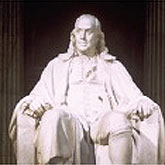Benjamin Franklin, Science Founding Father

In 1752, Franklin, along with his son William, performed his famous kite-flying experiment which proved that lightning is a naturally-occurring electrical phenomenon. The kite was constructed with a sharp metallic wire situated on top and at the end of the kite string, and a key tied to the end of the string with a silk ribbon. When Franklin saw loose threads on the kite string stand up, he grounded the makeshift insulated conductor by touching his knuckle to the metal key on the string. Consequently, he observed a passing spark between his knuckle and the key, which presented the final proof of lightning's electrical nature. Miraculously, the charge was not strong enough to be fatal to Franklin or his son. (Under normal circumstances, a lightning strike can instantly kill any individuals bold enough to fly a kite during a thunderstorm.)
In 1763, Franklin took part in discussions with colonial scholars about the effects of deforestation on local climate. As forests were cleared for farming in the early American colonies, Franklin agreed with the other colonials that 'cleared land absorbs more heat and melts snow quicker.' However, he thought that many years of observations were necessary before any conclusive evidence could be gathered on the effects of deforestation on the local climate. In addition to his meteorological prowess, Franklin also published the first scientific chart of the North Atlantic's Gulf Stream. He hypothesized that the trade winds cause the Gulf Stream by driving warm waters into the Gulf of Mexico, from where they exit by way of the Florida Strait and proceed to form the Gulf Stream. In 1775, on his way to England, Franklin lowered a thermometer into the Atlantic and found the Gulf Stream to be 6° F warmer than the surrounding sea and, subsequently, produced the first chart of the current.
About the Author
NASA NASA Earth Observatory
 NASA Earth Observatory is an online publishing outlet for NASA which was created in 1999. It is the principal source of satellite imagery and other scientific information pertaining to the climate and the environment which are being provided by NASA for consumption by the general public.
NASA Earth Observatory is an online publishing outlet for NASA which was created in 1999. It is the principal source of satellite imagery and other scientific information pertaining to the climate and the environment which are being provided by NASA for consumption by the general public.


